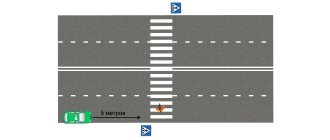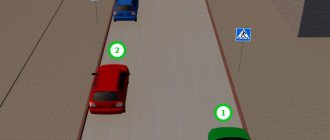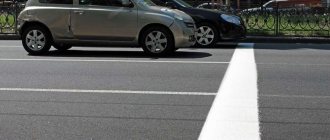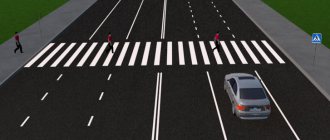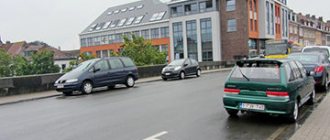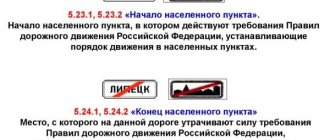Stopping and parking - the difference
The essence of both concepts is that the driver stops the car. The difference is in the duration and purpose of this “standing”. The stop has a specific purpose, for example, to let a passenger out or to go to the store. Therefore, the stop time is short - up to five minutes or more, if it is necessary to board (disembark) passengers and load (unload) the car. Anything longer than this time is considered parking by traffic regulations. These are the cases when your car is parked near your work during the day or near your home at night. And the parking lot has no purpose as such. The car is just waiting for its owner.
You can stop or park your car on the right side of the road - on the roadway or on the side of the road. But you need to be careful. The traffic rules contain a list of places where, in principle, you cannot stop or park a car. These bans exist to protect all road users and avoid accidents.
Where you can't stop
Places where you should not stop include:
- left side of the road (exception: single-lane road in a populated area);
- sidewalk;
- pedestrian crossings (on them or close to them - less than five meters);
- bike paths;
- railway crossings;
- tram rails;
- bridges (if there are less than three lanes in your direction);
- overpasses (on and under them);
- intersections and the distance less than five meters from them;
- roads near sharp, dangerous turns, where a car coming around the turn will have difficulty seeing a stopped car;
- narrow roads (or lanes of roads) - between the car and the opposite edge of the road (or marking line) is less than three meters;
- tunnels;
- any places where a stopped car will interfere with traffic: blocking the passage, traffic lights, road signs;
- under the "No Stopping" sign.
Where is stopping prohibited?
There is a fairly long list of places where stopping is prohibited . You must remember the indicated places and do not stop your car there. The full list is given in paragraph 12.4 of the traffic rules, which will be discussed in this article.
Tram rails
12.4. Stopping is prohibited:
- on tram tracks, as well as in the immediate vicinity of them, if this creates interference with the movement of trams;
Stopping is prohibited in the immediate vicinity of tram tracks if this will interfere with the movement of trams. In this part of the paragraph, everything is simple and clear.
However, the following point remains controversial. It is not clear to the driver whether stopping on tram tracks is prohibited in any case or whether it is prohibited only if the car interferes with the movement of trams.
The second situation may arise, for example, if in a populated area there are tram tracks that were previously used for tram traffic, but are currently abandoned. Since trams do not travel on these tracks, it is impossible to interfere with their movement. Is it possible to stop on tram tracks in this case or not?
In practice, I recommend not stopping on or near tram tracks. After all, even on abandoned tracks, sometimes there are trams, and next to them are traffic police officers, who will be happy to issue an appropriate fine.
Tunnels, overpasses, overpasses, bridges
12.4. Stopping is prohibited:
- at railway crossings, in tunnels, as well as on overpasses, bridges, overpasses (if there are less than three lanes for traffic in a given direction) and under them;
The features of stopping and parking at railway crossings were discussed in detail in this article. I recommend that you familiarize yourself with it.
Let's move on to tunnels, overpasses and overpasses. Stopping is always prohibited in tunnels and under overpasses and overpasses . The only difficulty a driver may encounter is how to distinguish a bridge, overpass and overpass from each other. In short, bridges are located over rivers, overpasses are over roads, and overpasses are over railways.
As for stopping on bridges, overpasses and overpasses, it is prohibited only if only 1 or 2 lanes are provided for traffic in a given direction. In other cases (3 or more lanes in a given direction), stopping on bridges, overpasses and overpasses is permitted.
Stop close to the markings
12.4. Stopping is prohibited:
- in places where the distance between a solid marking line (except indicating the edge of the roadway), a dividing strip or the opposite edge of the roadway and a stopped vehicle is less than 3 m;
The essence of this point is that if the remaining distance between your car and the opposite edge of the roadway, a solid marking line or a dividing strip is less than 3 meters, then stopping is prohibited.
Those. When choosing a place to stop, the driver must leave enough space so that other cars can pass without violating the rules.
Stopping is prohibited at pedestrian crossings
12.4. Stopping is prohibited:
- at pedestrian crossings and closer than 5 m in front of them;
Stopping is prohibited directly at pedestrian crossings , as well as in front of them. Stopping is permitted immediately after the pedestrian crossing.
To make it easier for you to understand the difference between the concepts of “before” and “after” the transition, follow the following rule. If there is a crossing on the road, then drive through it first, and only then stop.
There is one exception to this rule. If you want to stop on the left side of a two-lane road, you cannot stop immediately after crossing. You must either drive 5 meters after the crossing, or stop before reaching the crossing.
In any case, the car should not be stopped in such a way that it makes pedestrians “invisible” to drivers.
Limited visibility
12.4. Stopping is prohibited:
- on the roadway near dangerous turns and convex breaks in the longitudinal profile of the road when the visibility of the road is less than 100 m in at least one direction;
Stopping is prohibited if there is a dangerous turn in front of your car (indicated by signs 1.11.1, 1.11.2 “Dangerous turn”) or a break in the longitudinal profile of the road (top of a hill) and the visibility of the road is less than 100 meters.
I note that this requirement applies only to stopping on the roadway. Stopping on the side of the road will not be a violation of traffic rules.
1.11.1, 1.11.2 "Dangerous bend". Rounding a road with a small radius or with limited visibility: 1.11.1 - to the right, 1.11.2 - to the left.
In any case, you should not leave your car in places with limited visibility, because... the likelihood of an accident increases significantly.
Road intersections
12.4. Stopping is prohibited:
- at the intersection of roadways and closer than 5 m from the edge of the roadway being crossed, with the exception of the side opposite the side passage of three-way intersections (crossroads) that have a continuous marking line or dividing strip;
Stopping is prohibited at intersections of roadways and closer than five meters from them. Intersections of roadways are definitely present at intersections, but whether leaving the adjacent territory is an intersection of roadways is a very controversial issue.
In practice, I recommend not stopping closer than 5 meters to both intersections and exits from adjacent areas, because Such stops cause inconvenience to turning vehicles.
Bus and taxi stops
12.4. Stopping is prohibited:
- closer than 15 meters from the stopping places of fixed-route vehicles or parking for passenger taxis, indicated by marking 1.17, and in its absence - from the sign of the stopping place of fixed-route vehicles or parking for passenger taxis (except for stops for boarding and disembarking passengers, if this does not interfere with the movement of fixed-route vehicles vehicles or vehicles used as passenger taxis);
Stopping is prohibited or near bus or taxi stops In this case, the distance of 15 meters is measured either from markings 1.17, or from signs 5.16, 5.17, 5.18.
1.17 (color - yellow) - indicates the stopping places of route vehicles and taxi ranks;
5.16 “Bus and (or) trolleybus stopping place.”
5.17 "Tram stopping place."
5.18 "Taxi parking area."
In this case, please note that the phrase “from stopping places” is used, i.e. the no-stop zone extends in all directions.
For example, on two-lane roads it is prohibited to stop even on the opposite side of the road, because the distance turns out to be less than 15 meters.
As for the side of the road where the public transport stop is located, stopping is prohibited both before and after the stop (unlike, for example, the pedestrian crossing discussed above).
In addition, there is one exception. You can stop at and near public transport stops to pick up and unload passengers, but you must not interfere with public transport.
Signs and traffic lights
12.4. Stopping is prohibited:
- in places where the vehicle will block traffic lights, road signs from other drivers, or make it impossible for other vehicles to move (enter or exit) (including on bicycle or bicycle-pedestrian paths, as well as closer than 5 m from the intersection of a bicycle or bicycle-pedestrian path with roadway), or will interfere with the movement of pedestrians (including at the junction of the roadway and sidewalk on the same level, intended for the movement of people with limited mobility);
It is prohibited to stop a vehicle if it obscures traffic lights or road signs. This requirement applies to a greater extent to trucks, however, in some cases, a passenger car can also obscure road signs (for example, temporary ones) from other road users.
It is also prohibited to block entrances and exits with cars (for example, from the adjacent territory) and interfere with the movement of pedestrians. This requirement applies, for example, to those cases when stopping on the sidewalk is permitted by sign 6.4 and signs 8.6.2, 8.6.3, 8.6.6 - 8.6.9. You can find out more about stopping on the sidewalk in the article “Rules for stopping and parking.”
At the end of 2021, this paragraph also added a ban on parking on bicycle and bicycle-pedestrian paths, closer than 5 meters from the intersections of bicycle and bicycle-pedestrian paths with the roadway and next to low curbs intended for people with limited mobility to descend from the sidewalks.
Stopping in the bike lane
12.4. Stopping is prohibited:
- in the bike lane.
It is prohibited for vehicles to stop in the bicycle lane marked with road sign 5.14.2:
Motorway
16.1. On highways it is prohibited:
- stopping outside special parking areas marked with sign 6.4 or 7.11;
Stopping on the highway is permitted only at special areas marked with “Parking Place” or “Rest Place” signs:
If there are no such signs, then stopping on the highway is prohibited.
No Parking Sign
The "No Parking" sign is a blue circle bordered by a wide red border with a thin white outline bordering the colors. There is a red stripe running diagonally in the middle of the circle.
A sign with one diagonal stripe prohibits parking
Stopping and parking signs are very similar, so beginners can easily confuse them.
This has happened to me. To remember, I came up with such an association for myself. “OstZ” prohibits two actions: stopping and parking, so there are two red stripes on the sign, and “StoZ” prohibits one action (parking), which means there is only one red stripe. And my friend came up with another way to remember - by the first letters of the prohibited action: C and O. If you use your imagination, then there are clue letters on both signs. On “StoZ” the line divides the sign so that you get two letters C, looking at each other. This means that this sign prohibits parking. On “OstZ” you get the letter O (albeit with a cross inside). This means stopping is prohibited.
Penalties for illegal stopping and parking
For violations of parking/stopping rules, the Code of Administrative Offenses (hereinafter referred to as the Code of Administrative Offenses of the Russian Federation) provides for two main penalties: a fine and detention of the vehicle.
Fine
The Code of Administrative Offenses of the Russian Federation contains quite a few fines for non-compliance with Chapter 12 of the Traffic Regulations “Stopping and Parking”. They concern various violations in this area. The fine for stopping near the sign, i.e. in the prohibited zone, is prescribed in Article 12.16 of the Code of Administrative Offenses of the Russian Federation. It is equal to 1,500 rubles for all of Russia and 3,000 rubles for Moscow and St. Petersburg.
For other violations of parking/stopping rules, the state has established the following fines (and sometimes in addition other penalties):
- for stopping on a lane for fixed-route transport - 1,500 rubles, for Moscow and St. Petersburg - 3,000 rubles;
- for stopping/parking at a pedestrian crossing - 1000 rubles, in Moscow and St. Petersburg - 3000 rubles;
- for stopping/parking at a public transport stop - 1000 rubles, for Moscow and St. Petersburg - 3000 rubles;
- for stopping/parking on tram tracks - 1500 rubles, in Moscow and St. Petersburg - 3000 rubles;
- for stopping/parking on the roadway so that the car interferes with traffic - 2000 rubles, for Moscow and St. Petersburg - 3000 rubles;
- for stopping/parking at a railway crossing - 1000 rubles. or deprivation of a Sikh driver's license for six months;
- for stopping/parking in places for disabled people - 5,000 rubles;
- for violation of all other “minor” rules from Chapter 12 of the Traffic Regulations (for example, driving onto the sidewalk) - a warning or a fine of 500 rubles, in Moscow and St. Petersburg - 2500 rubles.
About all this - article 12.19 of the Code of Administrative Offenses of the Russian Federation.
Video: controversial situation with violation of parking rules
Discount on fine
If you hurry, you can pay not the entire fine, but only half of it. In the first 20 days after the resolution is drawn up and a fine is imposed, the violator has a 50% discount provided by law.
Car detention
If the car is parked under a prohibitory sign or in the zone of influence of such a sign, it can be taken to the impound lot (for a violation under Article 12.16 of the Administrative Code). But here you need to keep in mind: the fact that a tow truck is working should be warned by an additional information sign hanging under “OstZ” or “StoZ”.
You can take your car to the impound lot only if a special sign warns you about it.
In order to detain a car (that’s what this whole procedure with a tow truck is called), you need to draw up a protocol. Ideally, you should be present when it is compiled. But they can do this without you - they will record it on video or invite two witnesses. The protocol will indicate which rule you violated and will give you a punishment: a fine for illegal parking + detention of the car.
After the protocol, the car is taken away. How, when, who does this - these questions are answered by the laws of a specific region of the Russian Federation. That is, this process can occur differently everywhere. The main thing is that there is a protocol. There is no protocol - there is no reason to take the car.
But the return of the car is the same for all regions. The owner of the vehicle must pay a fine, which is issued along with the detention, the cost of transportation and maintaining the vehicle in the parking lot. After that he can take it away. At the impound lot, of course, you will need to show documents confirming that the car is yours or you have the right to drive it (for example, a compulsory motor liability insurance policy).
If you successfully managed to run while the car was just being processed for detention, and corrected your violation, for example, parked under a parking sign, and not under the “StoZ” sign, then the car will no longer be taken away. But before you fix it, you will need to confirm that the car is yours. Therefore, let the documents for the car always be with you, even if you left it for a short time.
A friend of mine left the car under a prohibitory sign. There was nowhere to park, and here, where he arrived, there was only half an hour to do. I decided that maybe it would pass. When the friend returned to the car, it had already been sealed and was about to be loaded onto a tow truck. The acquaintance, of course, ran up like a bullet: “Please don’t take it, I’m already leaving.” They ask him for documents confirming that the car is his. And the documents are in the car - my friend left for a while. Naturally, he didn’t show anything, and a sealed car cannot be opened without an inspector. (Cars are taken to the impound lot not by the State Traffic Safety Inspectorate, but by the Traffic Management Center, so there is no inspector during the arrest). And they took the swallow to the impound lot. On the same day, an acquaintance went to rescue the car. As you can imagine, the procedure became a little more complicated for him. I had to fill out a form stating that the car needed to be opened to remove documents. And after that, together with the inspector, open the car and take the documents. When everyone was convinced that my friend was the owner of the car, he paid the fine (with a 50 percent discount), transportation and maintenance of the car in the parking lot. Considering that the car did not sit there for even a day, the costs were relatively small (about 5,000 rubles: 3,000 rubles fine + other expenses). But the lesson was remembered for the rest of my life.
For violation - a fine
If these conditions are violated, you will have to pay a fine. “Violation of the rules for stopping or parking vehicles shall entail a warning or the imposition of an administrative fine in the amount of five hundred rubles. A violation committed in the federal city of Moscow or St. Petersburg entails an administrative fine in the amount of two thousand five hundred rubles,” as stated in Article 12.19 of the Code of Administrative Offenses of the Russian Federation.
If a car stops on a circle in places where fixed-route vehicles or taxis stop, or closer than 15 meters from places where fixed-route vehicles stop, with the exception of stopping to pick up or disembark passengers, this entails the imposition of an administrative fine in the amount of one thousand rubles, and in Moscow or St. Petersburg - three thousand rubles.
